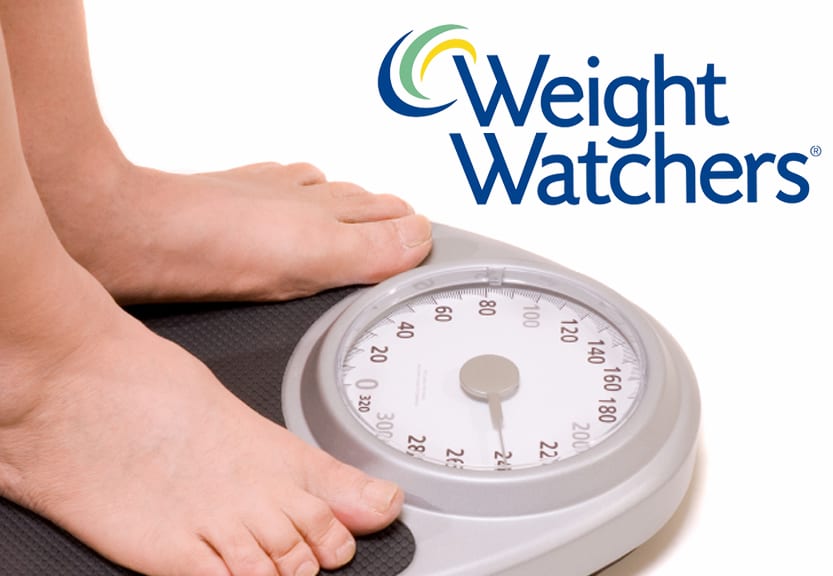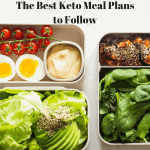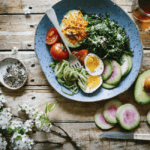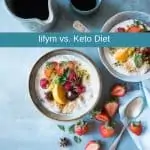As we age, our metabolic rate slows down and the processes of fat-burn and weight-loss become a lot more difficult.
So, staying slim and healthy after a certain age might seem impossible but it isn’t. In fact, there are only a couple of important things you must follow in order to become the master of your weight management challenge.
The following eating plans are some of the best diets for women over 50 and they can be easily customized to match one’s needs and preferences.
Topic Contents
Which Are the Most Effective Diets for Women Over 50?
1. Lean-Protein Weight-Loss Programs
When you’re trying to shed those extra pounds but your metabolism isn’t working the way it used to, one effective way to go is increasing the protein intake.
According to recent studies, women over 50 (particularly post-menopausal women) are able to lose significantly more weight if they follow a low-carb diet and high-protein diet without drastically lowering their calories. This was due to the fact that protein helps one’s organism to preserve lean muscle mass and therefore is ideal for long-term weight loss.
Don’t worry if you’re a vegetarian because you can get your protein amount from plant-based sources such as whey. Popular examples of high-protein weight-loss programs are Weight Watchers, the South Beach Diet, and the Atkins Diet.
a. Weight Watchers
Lose weight and get healthier with our science-backed myWW+ program and new personalized tools to help you eat well, move more, and feel your best.
Based on your current size and body measurements such as height, weight, age, and gender, you will receive a daily low-calorie diet budget. This diet allows you to eat all foods without restrictions. Still, there’s a catch! You must limit yourself to that number of points you receive when you become a member which translate into calories. On the other hand, if you act reckless, you might easily spend all your points on French fries and sweets which are not good at all and it will mean you’re cheating on your healthy diet.
b. The Atkins Diet
This diet is based on controlling and limiting your carbohydrate intake which further leads to an improved fat-burning process that will create energy as a fuel for your body. There are difference phases, initially with a low-calorie restriction diet for short-term weight loss, followed by long-term strategies to keep the weight off.
You will be allowed to consume protein from fish, chicken, eggs, and plant-based protein, high-fiber veggies, healthy fats such as avocados, olive oil, and nuts, Greek yogurt, as well as low-glycemic fruits like cherries, berries, and melon.
Once in a while, you can also eat legumes, whole grains, and starchy vegetables. However, you must completely give up sugar, trans fats, and refined flour. Atkins is definitely better than Weight Watchers because it is clinically-supported. Furthermore, the Atkins diet can be easily customized to one’s individual needs.
c. The South Beach Diet
Unlike Atkins diet which advises its dieters to include a variety of fats in their daily eating plans, the South Beach program minimizes saturated fat. For example, butter is a restricted diet food. Still, this system lets you consume non-starchy vegetables without any limitation whatsoever. Long story short, this diet is comprised of three main phases and you will be able to eat seafood, eggs (omega fatty acids), lean meat, legumes, vegetables, low-fat or fat-free cheeses, nuts, fruits, soy products, etc. Things like starchy carbs, alcohol, and fruit juices must be avoided.
NOTE ON PRICING: South Beach is currently offering 45% + 1 week FREE for all diet plans here. This is a pretty good deal relative to their historic pricing patterns.
Other Diet Programs to Consider
- Nutrisystem: They have been around for a long time, but adapted with the times. Always a great option to consider. Check out Nutrisystem here.
- Metabolic Factor: This is more cutting edge, but metabolic focused diets can be particularly effective, especially as middle aged metabolism slows down… Take the Metabolic Factor Quiz here to see if it’s a good fit for you.
- Wonderslim: Highly cost effective and customized. Think of it like Nutrisystem BUT much more affordable because you can pick and choose manually. Check out Wonderslim here.
2. Fruits and Veggies Weight-Loss Diet
If you’re a vegan or vegetarian or you’re simply not a big fan of meat, there’s another possible option out there suitable for you. There are several popular and effective eating systems that focus on veggies and fruits consumption. According to research, women are prone to lose more weight if they eat less cheese and meat while increasing their fruit and vegetable intake.
Some of the women’s weight loss diets for over 50 women that have an emphasis on these two aforementioned types of foods are the Mediterranean eating plan, the Mayo Clinic diet, and DASH diet.
a. Mediterranean Diet
There are several recommendations you must follow when you’re on the Mediterranean diet:
- Eat more fish;
- Use only extra-virgin olive oil;
- Eat a lot of vegetables, all day long;
- Include small portions of whole grains in your daily diet;
- Consume nuts as healthy snacks;
- As for desserts, you should focus on fruits;
- Indulge in a glass of red wine from time to time.
During this diet plan, you can consume the following food categories:
- Large quantities of fruits, veggies, legumes, whole grains, herbs, fish, spices, seafood, olive oil, nuts, and seeds;
- In moderation, you can also eat eggs, yogurt, poultry, and cheese;
- Red meat is to be eaten rarely;
- Avoid added sugars, refined grains, beverages that contain sugar, processed meat, refined oils, as well as highly-processed foods.
b. Mayo Clinic Diet
The Mayo Clinic diet has the sole purpose of helping you eat well, lose weight, and enjoy life. According to the clinic, they have a different approach to the entire process of weight-loss. Unlike many other diets, this one requires a long-term commitment. The Mayo Clinic diet has two main phases:
- Lose It! – the first phase lasts for two weeks and it was created to help dieters jump-start their weight-loss. They can lose between 6 and 10 pounds in both a healthy and safe manner. What I like about this program is the fact that their specialists will teach you the proper way to change your entire lifestyle and gain new healthier eating habits.
- Live It! – the second phase will last a lifetime and it can revolutionize your old belief of how a diet must be followed. During this second phase, you will learn more about correct portion sizes, healthy food choices, physical activities (some minor strength training), menu planning, and other important aspects. Usually, dieters tend to lose 1-2 pounds per week.
You will have to stick to a 1200-calorie meal plan per day which consists of the following items:
- A minimum of 4 portions of vegetables;
- At least 3 fruit servings;
- Around 4 servings of carbs but not just any carbs; you must select the ones that are “smart” such as whole grains;
- 3 portions of healthy fats;
- Around 3 servings of low-fat dairy or lean protein.
Note: You can contrast the Mayo Clinic Diet vs Weight Watchers further if you are interested OR check out the Mayo Clinic program directly here.
c. DASH Diet
At first, this diet was created to lower blood pressure as a natural remedy that substituted medication. Nowadays, this eating regimen also works as a weight-loss diet which is recommended for women over 50.
The diet is basically simple. You must consume more vegetables, fruits, fish, low-fat dairy products, whole grains, nuts, and poultry. On the other hand, you must limit sweets, red meats, sodium, sugary drinks, etc. Don’t forget to cut back on products that contain too much cholesterol, trans fats, and saturated fats.
3. Diets that Support a Healthy Heart
Besides gaining weight, another, probably more important risk for women over 50 is represented by chronic health conditions such as high blood pressure, heart disease, and diabetes. All these might appear because of hormonal changes. Therefore, it is only wise to focus on weight-loss diets that target fat burn as well as certain health issues. Some of the most effective eating systems that also support a healthy heart are the TLC diet along with the Ornish diet.
These two programs will control your blood sugar level, count your carb intake, and use the Glycemic index in order to teach you how to make proper dietary choices.
a. The TLC Diet
TLC is not the popular TV Channel we all know. In this case, the acronym stands for Therapeutic Lifestyle Changes which is a well-known heart-healthy eating system. It is known to lower cholesterols as well as the risk of heart conditions such as strokes. It is mainly about consuming a lot less fatty foods and focuses more on healthy types of fats. This diet was initially designed for patients who were dealing with high levels of bad cholesterol. Here’s what to do to follow the TLC diet:
- First and foremost, you must establish the number of calories you want to consume on a daily basis – it should be around 1600 or even less but this figure will vary depending on your body type, metabolic rate, height, weight, age, and physical activity as well as your overall lifestyle;
- You’re not allowed to eat more than 5 ounces of meat per day. Also, you must consume lean protein like skinless turkey or chicken, fish, low or non-fat dairy products, etc.;
- Each day, you should have a soluble fiber intake of 10-25 grams which you will find in items like seeds, lentils, beans, and nuts;
- Make sure to eat a couple of portions of fruits per day (no less than 2 but no more than 4);
- Finally, you must consume between 3 and 5 vegetable servings per day.
On a TLC diet, you must avoid high-cholesterol or high-fat food products. Other items like eggs can be consumed in moderate amounts. For example, you can have two egg yolks each week.
b. The Ornish Diet
The Ornish diet encourages dieters to consume more good carbohydrates, healthy fats, and good lean protein. On the other hand, people who follow this eating program must lower their high-glycemic carbs, bad protein, and potentially-harmful fats consumption. Most importantly, this diet encourages you to eliminate processed foods from your eating habits and replace them with natural whole foods.
Ornish is more than a simple diet. It is a lifestyle program comprised of four main components:
- Proper and healthy nutrition – mostly a plant-based diet made from vegetables, organic fruits, legumes, and whole grains. You are also allowed to consume moderate amounts of nonfat dairy products and a couple of egg whites per week; so, this is a restrictive low-fat diet;
- Moderate exercise – with an emphasis on brisk walks a couple of times per week;
- Stress management – one hour of mindfulness meditation or even yoga each day;
- Social support – becoming a member of the Ornish Diet’s community and giving and receiving help to and from other members who are going through the same challenge as you.
4. Diets Based on Regular Physical Activities – Getting Your Groove on
If you’re truly committed to losing weight and maintain your health, you should know that eating well is just the first piece of this complex puzzle. To make the puzzle reveal a complete image, you need to also include regular exercise in your lifestyle. Ideally, you should engage in moderate-intensity workouts every day for at least 30 minutes per session.
Besides brisk walks and bike rides, fitness and nutrition experts also recommend two weight-training sessions each week which will help you preserve and build muscle mass. If you can afford it, you could even benefit from the knowledge and experience of a personal trainer.
Top Exercise Based Diet Programs to Try
- Noom Fitness: Noom is one of the fastest growing new trends. It’s popular with milennials because it’s all managed through smartphone apps, BUT if you are a tech-savvy 50+ person (as many of us are), it’s a great system. You can learn more about Noom here.
- 21 Day Fix: One of the most popular and successful home training progams, the 21 Day Fix can be completed in the comfort of your home, without the public setting of a gym or the need for a personal trainer. See how the 21 Day Fix works OR sign up directly here.
5. The Decade Diet
The Decade diet is a customized eating regimen made especially for women over 50 and focuses on low-fat food items. It was created by Linda Foster who is both a nutritionist and a health expert. There is no such thing as a standard miracle diet that works the same for all people but this is not that surprising and Linda is well-aware of that. Each body reacts differently to a certain diet. Furthermore, our organism, especially metabolism, changes quite a lot over the years.
The Decade diet consists of consuming plenty of veggies, fruits, oats, and whole-meal bread. As I mentioned previously, it is a low-fat eating system so you must follow and apply certain strict rules including what you should eat for each meal of the day: breakfast, mid-day snack, lunch, evening snack, dinner, etc. Here are some tips and tricks on what to include in your daily diet for each part of the day:
- Breakfast – whole grains (whole-grain cereals), lean proteins (peanut butter, almonds, poached eggs), home-prepared smoothie with semi-skim milk, half of a banana, strawberries, free-fat yogurt, grilled tomatoes, etc.;
- Lunch – avoid extra cheese to limit calorie the overall calorie intake and use a mixture of lemon juice and olive oil to cook your meals; consume whole meat pita, tuna salad, California sushi rolls, lentil soup, low-fat yogurt, etc.;
- Dinner – vegetables, kidney beans, lean grilled steak, carrots, mushrooms, tomatoes, red peppers, brown rice, stir-fried chicken, soy sauce, egg noodles, fish, asparagus, broccoli, etc.;
- As for the snacks, you can never go wrong with oatcakes, olives, fruits, mixed nuts, or low-fat yogurt.
This specific eating regimen also encourages you to engage in regular physical activities. Don’t fret if you’re not a fan of intense workouts. You can easily work your muscles through power-walking which is recommended a couple of times per week for a minimum of 45 minutes per session.
Final Thoughts on the Best Diet for Women Over 50
If the hot flashes are an indication your body is changing, it’s true. But in more ways than one. As your metabolism slows down, a whole host of other health concerns arise. It’s not a losing proposition though!
If you’re over 50 and you want to prevent muscle mass loss, you should definitely try one or more of the weight-loss programs described above. They encourage a healthy way of living, from consuming whole foods to engaging in regular physical activities.
All these ideas might save you a lot of problems and headaches down the road. It’s never too late to start living a healthier lifestyle. Even SMALL changes can help in BIG ways!
Further Reading on Diets
- South Beach Diet vs Atkins Diet Compared
- South Beach vs Paleo Diet Compared
- South Beach vs Nutrisystem Diet Compared
- South Beach vs Keto Compared
- Atkins vs Nutrisystem Diet Compared
- Weight Watchers vs Jenny Craig Compared
- Mediterranean Diet vs Keto Diet Compared
- The Best Ways to Actually Start a Diet
- Dukan Diet vs Keto Diet
- Mayo Clinic vs Dash Diet Compared
- Weight Watchers vs 21 Day Fix Compared
- Nutrisystem vs Slim Fast Compared
Medical Review Comments from Dr. Robin Walsh, BASc, ND
It is important to understand that the dietary program that works is the one that you are able to sustain. First and foremost the plan you choose needs to become a lifestyle and not just a fad. I always tell my clients that it is better never to lose the weight at all, then constantly gain and lose the same thirty pounds.
It becomes more challenging for women going through menopause to shed those pounds..but not impossible. As estrogen levels decrease, it affects our insulin levels and tends to cause more body fat to accumulate around the middle.
While most dietary plans will work, the ones that are whole food based and lower in carbs tend to be the most successful. I also like to incorporate intermittent fasting in most of my dietary plans to encourage insulin balance and fat loss.
While it may be more difficult to shed those menopausal pounds, it is not impossible. If you are struggling, it is important to find a practitioner that can help you navigate what plan is right for you…and your hormones.
Note: Dr. Robin Walsh is not associated with any products, will never recommend a specific product, nor give specific medical advice here in her contributions. She comes as a representative of herself alone and always recommends consulting with your primary care physician before making any health-related decisions.
Disclaimer
Last updated: December 16, 2019
The information contained on www.altprotein.com website (the “Service”) is for general information purposes only.
Alt Protein assumes no responsibility for errors or omissions in the contents on the Service.
In no event shall Alt Protein be liable for any special, direct, indirect, consequential, or incidental damages or any damages whatsoever, whether in an action of contract, negligence or other arising out of or in connection with the use of the Service or the contents of the Service. Alt Protein reserves the right to make additions, deletions, or modification to the contents on the Service at any time without prior notice.
Alt Protein does not warrant that the Service is free of viruses or other harmful components.
Fitness disclaimer
The Service offers health, fitness and nutritional information and is designed for educational purposes only. You should not rely on this information as a substitute for, nor does it replace, professional medical advice, diagnosis, or treatment. If you have any concerns or questions about your health, you should always consult with a physician or other health-care professional.
Do not disregard, avoid or delay obtaining medical or health-related advice from your health-care professional because of something you may have read on the Service. The use of any information provided on the Service is solely at your own risk.
You can also review our Editorial Integrity Policy.
Alt Protein Team is a team of professionals and enthusiasts committed to bringing you the most up-to-date information on alternative protein, health and wellness, workouts, and all things health-related. We’ve reviewed a lot of products and services so you don’t have to guess when you spend your hard-earned money on them. Whether you want to shed some pounds, build lean muscle or bulk, we can help you figure out what you need to do and what you need to have to achieve your goals.













